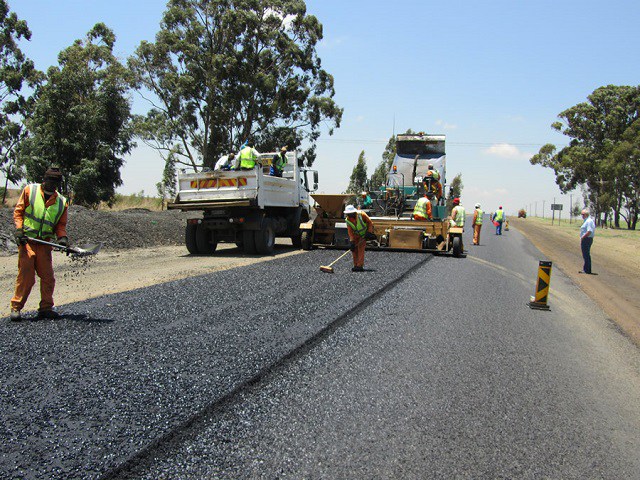Major road works set for completion
The last gaps in the Harare-Masvingo-Beitbridge highway are the primary target on the Government’s infrastructure programme this year, while the modernisation of Forbes and Nyamapanda border posts is set to start, Transport and Infrastructural Development Minister Felix Mhona has said.
The Second Republic led by President Mnangagwa has invested heavily in infrastructural development, mainly transport and energy infrastructure, which are seen as key to transforming the economy.
Using locally-generated resources, the Second Republic has so far rehabilitated more than 50 000km of roads while 2 000 structures have been attended to since the start of the Emergency Road Rehabilitation Programme (ERRP) in 2021.
Zimbabwe has an estimated road network of 84 000km, out of which 93 percent was in fair or poor condition and in need of rehabilitation or periodic maintenance.
Government is also in the process of negotiating with potential investors for the rehabilitation of some of the country’s roads.
Another major road restoration programme is expected to be rolled-out soon, targeting not only highways, but also those roads in communities and other feeder roads to ensure no one and no place is left behind.
In an interview, Minister Mhona said Government’s immediate task was to complete pending projects including the Harare-Masvingo-Beitbridge highway.
“Our visionary leader President Mnangagwa has pushed us to use our resources, which we seized as a ministry to complete the Harare-Beitbridge road where we have done 470km and we are left with 110km.
Minister Mhona said the Government had started engagements on how to enhance the corridors into Mozambique so they become smooth gateways.
“We are looking at Forbes Border Post and Nyamapanda Border Post where concession agreements will be signed soon,” he said.
The concession-style agreement was used to transform the Beitbridge Border Post into the much-praised upgrade now in use.
On the Mbudzi Interchange in Harare, a critical part of the road rehabilitation drive in general and in particular the elimination of congestion on the busy highway that links Zimbabwe with a number of SADC countries, Minister Mhona said civil works were almost halfway complete.
“We are confident that it will be complete by midyear and part of it will be visible. We were seized with compensation and relocation (of affected families and businesspeople) and there are feeder roads that are being constructed,” he said, referring to the need to buy out householders and businesses near the interchange so there was room for the multi-layered set of bridges that form the interchange.
The US$88 million project has created over 700 direct jobs and thousands of indirect jobs.
The Mbudzi interchange is at the intersection of Simon Mazorodze Road, Chitungwiza Road and High Glen Road in Harare. Local financial institutions are funding the project, which is being implemented by three local companies; Tensor Systems, Fossil Contracting and Masimba Construction, who have formed a joint venture called Tefoma Construction.
Negotiations between Government and a potential investor for the rehabilitation of the Harare-Nyamapanda highway and the Nyamapanda Border Post are underway.
The 235,8km Harare-Nyamapanda highway, which links Zimbabwe with Mozambique and Malawi, has been affected by an increase in traffic, especially haulage trucks transporting black granite from Murehwa and Mutoko.
It has also become narrow on some stretches, making its rehabilitation vital to ensure the safety of passengers, goods being transported and the vehicles themselves.
After the Harare-Masvingo-Beitbridge highway has been completed, focus will then move to the northern leg of the main north-south corridor, the Harare-Chirundu highway, where some parts of the road after Karoi almost as far as the border, need major work.
Present road works are aimed at rehabilitating some of the ugliest stretches to minimise damage on vehicles and potentially reduce the chances of fatal road accidents.
The entire north-south corridor has been divided into three sections: the 580km Harare-Masvingo-Beitbridge highway together with eight toll plazas, the 342km Harare-Chirundu highway with six toll plazas, and the 59km Harare Ring Road with three toll plazas. These tolls are aimed at paying for the rehabilitation and maintenance of roads.
In terms of the Harare-Mutare dualisation process, 46km between Harare and Marondera have already been completed and opened to traffic, and works will continue.
Many other key highways are being rehabilitated, including the Beitbridge-Bulawayo-Victoria Falls highway, for the local travellers and more importantly tourists using the road to one of the world’s seven natural wonders.
The Beitbridge Border Post, one of President Mnangagwa’s signature infrastructure projects, has already been completed and travellers are enjoying seamless movement.
The processing time of people, light and heavy vehicles including trucks and buses, now takes a shorter period compared to the past, after the transformation of the key border by Government in a private-public-partnership with the Zimborders Consortium at the cost of US$300 million.
Beitbridge Border Post modernisation and associated works in the town brought with it a number of developments including the 220-staff village for border staffers, the 11,4 megalitre water reservoir, a brand-new fire station, and a plant and animal quarantine centre, among others.
In terms of aviation, President Mnangagwa commissioned the upgraded and expanded terminal for US$153 million Robert Gabriel Mugabe International Airport in July, exactly three years from the day a ground-breaking ceremony was done.
The airport will soon become a regional aviation hub, able to handle about 6 million passengers annually, from the present 2,5 million.
The upgrading of the RGM International Airport is also expected to see more international airlines opening routes into Harare and a corresponding increase in tourist arrivals.
Infrastructure development is at the heart of the Second Republic, which has a vision of as the Second Republic continues to deliver key projects in line with the country’s vision of transforming Zimbabwe into an empowered upper middle-income economy by 2030.
-herald








